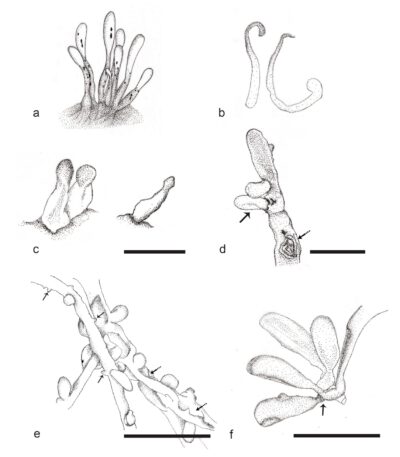Fungalpedia – Note 270, Abieticola
Abieticola Hyang B. Lee.
Citation when using this entry: Perera et al. 2024 (in prep) – Fungalpedia, genera described in 2016.
Index Fungorum, Facesoffungi, MycoBank, GenBank, Fig. 1
Classification: Xylariaceae, Xylariales, Xylariomycetidae, Sordariomycetes, Pezizomycotina, Ascomycota, Fungi
Lee et al. (2016) introduced the monotypic hyphomycetous genus Abieticola to accommodate A. koreana, based on the phylogeny of ITS, LSU, rpb2, and tub2 markers. Abieticola koreana is an endophytic species isolated from inner bark of Abies holophylla (Lee et al. 2016). Abieticola is distinguished by stromata that typically form on PDA, resembling tiny clubs with white heads and blackish brown exudates oozing out along the lower stalk. Synnemata are generally erect but curving with age, with knotted hyphae of variable thickness, brown to yellow in color, and functioning as conidiophores. One or two (occasionally three) conidia form laterally on mycelia and detach with characteristic scars. They are poronia-like, ellipsoid or fusoid to ovoid, typically slightly curved, hyaline with a brown-to-yellow base, and a white to grey tip. However, the sexual morph has not been determined (Lee et al. 2016). Abieticola differs from Poronia species in having shorter conidiogenous cells and slightly curved conidia (Lee et al. 2016).
Type species: Abieticola koreana Hyang B. Lee
Other accepted species: This genus is monotypic
Figure 1 – Abieticola koreana (CNUFC EML-F0010-1, holotype). a MEA culture with abundant mycelia and aerial club-like synnemata with long whitish heads and yellowish bases. b Old fruit bodies producing whitish powdery conidia and hairy mycelia on PDA. c Fruit bodies of the vase-shaped structure on PDA. d Conidia (solid arrow) and scar (dotted arrow) formed on mycelia e Conidia and normal mycelia with small knots (solid arrow) and flat mycelia (dotted arrow). f Conidiation in cluster (solid arrow) on mycelia. Scale bars: c = 1 mm, d, f = 5 μm, e = 10 μm. Redrawn from Lee et al. (2016).
Reference
Entry by
Rekhani Hansika Perera, Center of Excellence in Fungal Research, Mae Fah Luang University, Chiang Rai, 57100, Thailand.
(Edited by Kevin D. Hyde, Samaneh Chaharmiri-Dokhaharani, & Achala R. Rathnayaka)
Published online 28 May 2024
